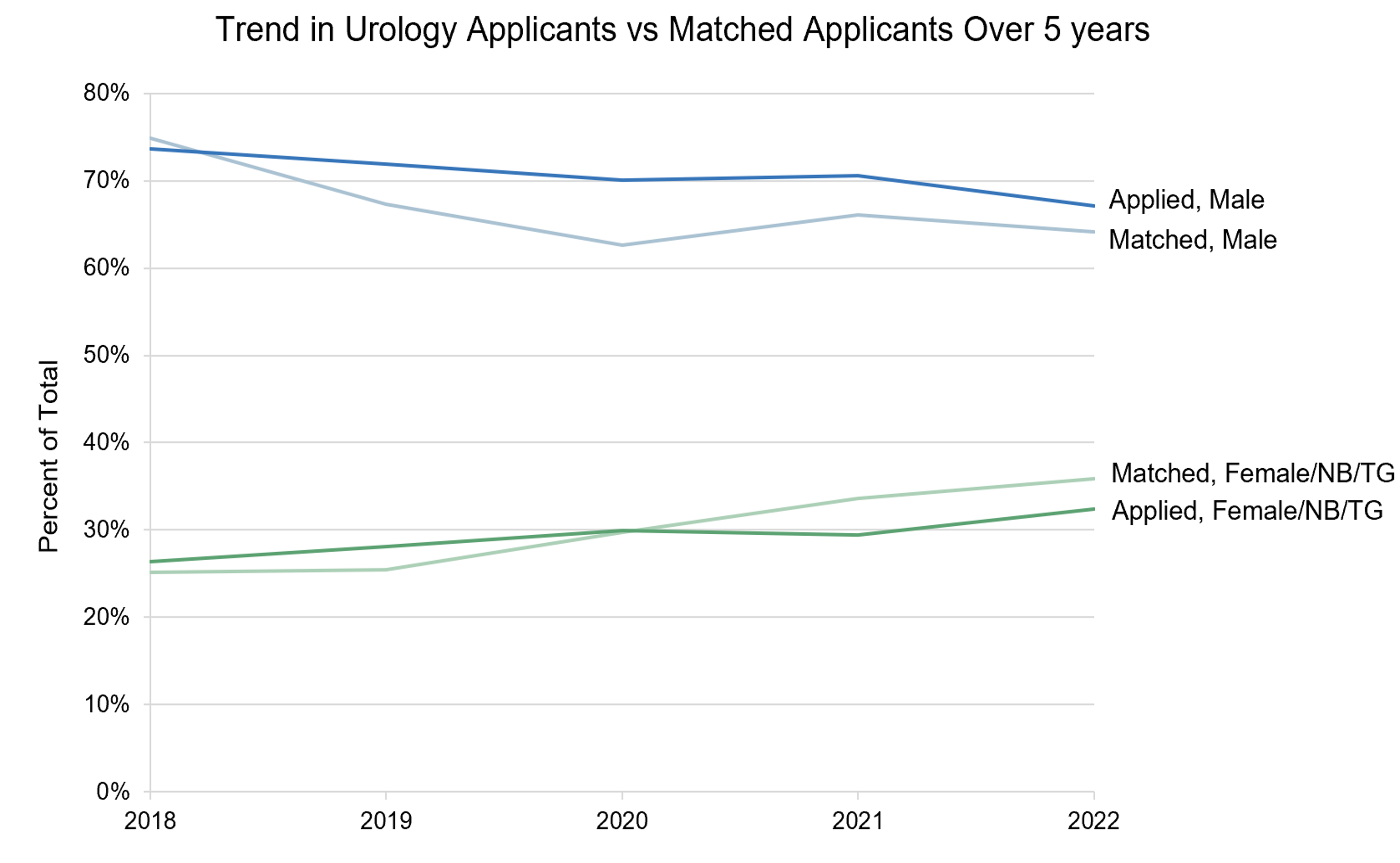Back
Introduction: In the past decade, urologists have seen an increase in the number of female as well as gender diverse patients. Therefore, it is important that the field of urology reflects gender diversity within their workforce. The primary objective of this study was to evaluate the trend in the gender of matched urology applicants over the past 5 years and in addition, compare this trend to other surgical subspecialties.
Methods: Data was collected on resident demographics and match statistics through the ACGME and AUA respectively, available online from the years 2017-2022. Chi-squared, linear regression and ANCOVA analyses were run using R software with a p-value of 0.05 used for significance.
Results: Last year, 2021, was the first year the AUA reported the gender marker non-binary and transgender (NB/TG) for urology residency applicants. This year, 2022, was the first proportion of matched NB/TG applicants was described (33%). There were significantly less female and NB/TG applicants matching into urology than males between the years 2018-2022 (p = 0.017). While the rate of female/NB/TG identified applicants to urology has increased, the rate of female/NB/TG identified individuals matching into urology was significantly higher over the past 5 years (1.3 % per year vs. 2.9% per year, respectively) (p = 0.014). The number of female/NB/TG identified residents was highest in general surgery and with the greatest overall increase of 7.4% over 5 years. Urology, neurosurgery, and orthopedic surgery had the lowest percentages overall, but all increased ~3% over 5 years. The proportional increase from 2017 however, was higher in neurosurgery and orthopedic surgery (17.2% and 19.7% respectively) than urology (11.9%).
Conclusions: Almost all surgical subspecialties have seen an increase in the number of female/NB/TG residents. The most recent 2022 match data reported the highest proportion of matched females (35.6%) and NB/TG applicants (33%). Interestingly, the number of matched female/NB/TG individuals increased at a rate greater than expected based on the number of applicants. Despite this increase, representation is still significantly lower than males. Taken together, this could be the first evidence of success of initiatives by urology residency programs to support equity, diversity and inclusion. SOURCE OF
Funding: None

Moderated Poster Session
Session: MP57: Diversity, Equity & Inclusion: Increasing Representation in Urology
MP57-16: Closing the Gender Gap in Urology and Other Surgical Specialties
Sunday, April 30, 2023
9:30 AM – 11:30 AM CST
Location: S405

Guillaume Farah, MD
University at Buffalo
Poster Presenter(s)
Introduction: In the past decade, urologists have seen an increase in the number of female as well as gender diverse patients. Therefore, it is important that the field of urology reflects gender diversity within their workforce. The primary objective of this study was to evaluate the trend in the gender of matched urology applicants over the past 5 years and in addition, compare this trend to other surgical subspecialties.
Methods: Data was collected on resident demographics and match statistics through the ACGME and AUA respectively, available online from the years 2017-2022. Chi-squared, linear regression and ANCOVA analyses were run using R software with a p-value of 0.05 used for significance.
Results: Last year, 2021, was the first year the AUA reported the gender marker non-binary and transgender (NB/TG) for urology residency applicants. This year, 2022, was the first proportion of matched NB/TG applicants was described (33%). There were significantly less female and NB/TG applicants matching into urology than males between the years 2018-2022 (p = 0.017). While the rate of female/NB/TG identified applicants to urology has increased, the rate of female/NB/TG identified individuals matching into urology was significantly higher over the past 5 years (1.3 % per year vs. 2.9% per year, respectively) (p = 0.014). The number of female/NB/TG identified residents was highest in general surgery and with the greatest overall increase of 7.4% over 5 years. Urology, neurosurgery, and orthopedic surgery had the lowest percentages overall, but all increased ~3% over 5 years. The proportional increase from 2017 however, was higher in neurosurgery and orthopedic surgery (17.2% and 19.7% respectively) than urology (11.9%).
Conclusions: Almost all surgical subspecialties have seen an increase in the number of female/NB/TG residents. The most recent 2022 match data reported the highest proportion of matched females (35.6%) and NB/TG applicants (33%). Interestingly, the number of matched female/NB/TG individuals increased at a rate greater than expected based on the number of applicants. Despite this increase, representation is still significantly lower than males. Taken together, this could be the first evidence of success of initiatives by urology residency programs to support equity, diversity and inclusion. SOURCE OF
Funding: None

